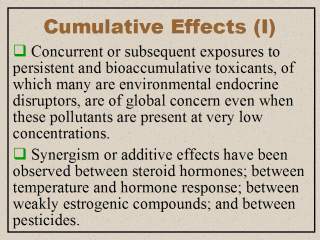| front |1 |2 |3 |4 |5 |6 |7 |8 |9 |10 |11 |12 |13 |14 |15 |16 |17 |18 |19 |20 |review |
 |
In the USA, the
concern over chemicals that are persistent, bioaccumulative, and toxic is
well reflected in the Food Quality Protection Act of 1996. The law mandated
the U.S. EPA to determine the combined risk for chemicals that have a common
mechanism of toxicity. Concurrent or subsequent exposures to multiple
chemicals having a common mode of toxicity may increase risk due to
cumulative effects. As for environmental endocrine disruptors (EEDs), some
of their cumulative effects are real and hence worrisome. In many places, EEDs are indeed present at very low concentrations, often well below the threshold of adverse effects. The recurring challenge often encountered is hence the question whether or not environmental pollutants at such low levels can have the ability to disrupt the endocrine system. Available data appear to have resolved this recurring challenge. For example, according to McLachlan et al. (1997), synergism effects have been observed between steroid hormones (Kephart et al., 1996); between temperature and hormone response (Wibbels et al., 1991); and between weakly estrogenic compounds (Bergeron et al., 1994). The study by Arnold et al. (1996) further claimed up to a 1,600-fold synergistic interaction between each pair of chlordane, dieldrin, endosulfan, and toxaphene tested in a series of competitive estrogen receptor-binding assays and in an estrogen-responsive assay in yeast. Although the synergistic interactions observed in the Arnold study could not be reproduced in other laboratories and the study was later withdrawn by one of the co-authors (McLachlan, 1997), Ramamoorthy et al. (1997) nonetheless were able to observe additive effects between each pair of these weakly estrogenic pesticides when they repeated the in vitro assays. |